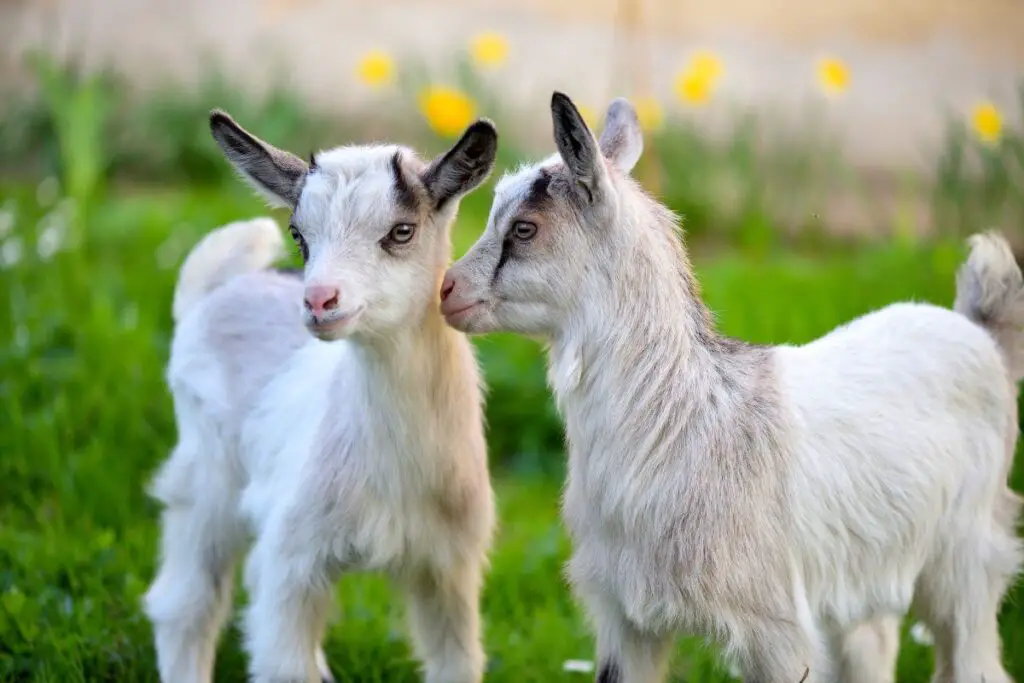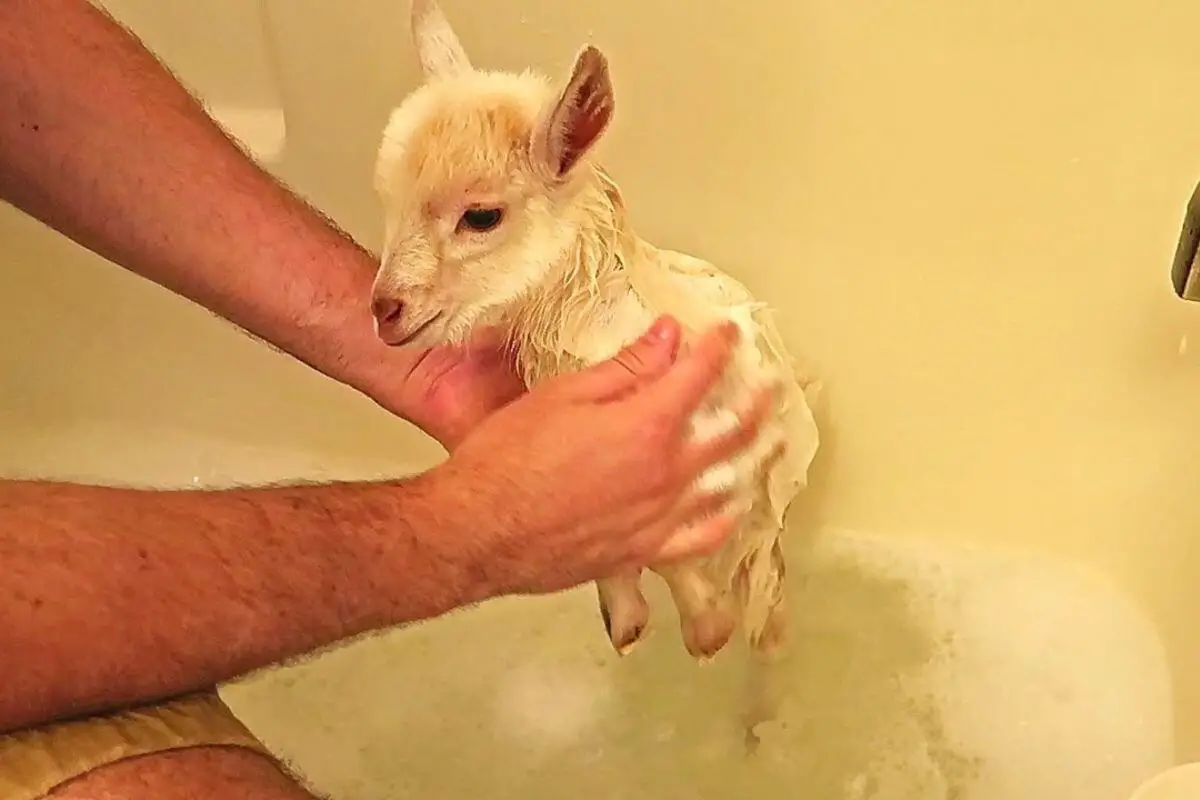As charming as goats may be, they often find themselves in amusing predicaments, and one question that occasionally arises is, “Can you give a goat a bath?” Goats, known for their playful antics and sometimes messy escapades, might end up needing a good cleaning. Let’s explore the considerations, challenges, and potential benefits of bathing a goat.
Understanding Goat Hygiene:
Goats are generally clean animals that groom themselves by nibbling on their coats, scratching against objects, and rolling in the dust. However, certain circumstances may necessitate a bath for a goat. These circumstances can include:

**1. Contamination or Stains:
- Goats may encounter substances like mud, feces, or other contaminants that can cling to their coats, creating a need for a thorough cleaning.
**2. Health Concerns:
- In some cases, goats with health issues, skin conditions, or external parasites may benefit from a bath as part of their care and treatment.
**3. Show or Competition Preparation:
- For goats participating in shows or competitions, a bath might be part of the grooming process to present them at their best.
Challenges of Bathing a Goat:
While the idea of a goat bath may seem amusing, there are challenges to consider:
**1. Goat Discomfort:
- Goats are not naturally fond of water, and the bathing process can be stressful for them. Ensuring a calm and gentle approach is essential to minimize stress.
**2. Proper Handling:
- Proper restraint is crucial to ensure the safety of both the goat and the person giving the bath. Some goats may resist being bathed, so gentle handling and patience are key.
**3. Drying Concerns:
- Goats need to be thoroughly dried after a bath to prevent chilling. This is particularly important in colder weather, and ensuring a warm and dry environment post-bath is essential.
Tips for Bathing a Goat:
**1. Choose the Right Location:
- Select an area with good drainage to avoid creating a muddy mess. A designated bathing spot with a non-slip surface is ideal.
**2. Gather Necessary Supplies:
- Have all supplies ready, including mild goat-friendly shampoo, towels, and a brush. Ensure the water temperature is lukewarm to avoid shocking the goat.
**3. Gradual Introduction to Water:
- Start by introducing the goat to water gradually. Use a hose or a shallow tub and allow them to get used to the sensation.
**4. Gentle Scrubbing:
- Use a gentle scrubbing motion with the shampoo to clean the coat thoroughly. Pay attention to areas that may have stains or debris.
**5. Rinse Thoroughly:
- Ensure a thorough rinse to remove all traces of soap. Residual soap can irritate the goat’s skin.
**6. Towel Dry and Shelter:
- Towel dry the goat as much as possible and provide a warm, dry shelter to prevent chilling.
When to Seek Professional Help:
**1. Health Concerns:
- If bathing is required for health reasons, it’s advisable to consult with a veterinarian to ensure proper care and treatment.
**2. Resistance or Agitation:
- If a goat consistently resists bathing or becomes overly agitated, seeking the assistance of a professional with experience in goat handling may be beneficial.
Conclusion: A Glimpse into Goat Grooming:
While the idea of giving a goat a bath might bring a smile, it’s essential to approach the process with sensitivity and respect for the goat’s comfort. Bathing should be done when necessary for hygiene or health reasons, and gentle handling is crucial to ensure a positive experience for both the goat and the caregiver. So, whether your goat needs a bath after a muddy escapade or as part of a grooming routine, approach the soapy dilemma with patience, care, and a touch of goat-friendly shampoo.
Navigating the Sudsy Saga: Tips for a Successful Goat Bath
As you embark on the sudsy adventure of giving your goat a bath, it’s essential to consider additional tips that can contribute to a successful and stress-free experience for both you and your caprine companion.
1. Positive Reinforcement:
- Encourage positive associations with bath time by offering treats or favorite snacks before, during, and after the bath. This can help create a sense of reward and make the experience more enjoyable for the goat.
2. Team Effort:
- If possible, enlist the help of a second person to assist with the bathing process. One person can focus on gently restraining and soothing the goat, while the other manages the washing and rinsing. Teamwork can make the process smoother and less stressful.
3. Introduce Water Gradually:
- Some goats may be apprehensive about water. To ease them into the bathing process, start by allowing them to explore a shallow tub with a small amount of water. Gradually increase the water level as they become more comfortable.
4. Mindful Drying:
- Towel drying is a crucial step in the bathing process. Use absorbent towels to remove excess water from the goat’s coat. If the weather permits, allowing the goat to air-dry in a warm, sheltered area is ideal. If needed, a gentle blow dryer on a low setting can be used, ensuring it doesn’t cause distress.
5. Seasonal Considerations:
- Be mindful of the weather conditions when planning a goat bath. Bathing in colder temperatures requires extra care to prevent chilling. Choose a warm day, and if necessary, use heat lamps or provide extra bedding to keep the goat warm post-bath.
6. Regular Grooming Routine:
- Incorporate bathing into a regular grooming routine to make it a familiar and expected part of the goat’s care. This helps reduce anxiety associated with unexpected or infrequent baths.
7. Consult with Experienced Handlers:
- If you’re new to goat care or encounter challenges during the bathing process, seek advice from experienced goat handlers, local farmers, or veterinary professionals. Their insights can be invaluable in addressing specific goat behaviors or health considerations.
8. Choosing Goat-Friendly Products:
- Use shampoos specifically formulated for goats or other livestock. These products are designed to be gentle on the goat’s skin and coat, avoiding irritation. Harsh chemicals or strong scents may cause discomfort, so opt for mild and goat-friendly options.
9. Establishing a Comfort Zone:
- Designate a specific area for goat bathing, ensuring it’s secure, easily accessible, and provides a sense of familiarity. Consistency in the bathing environment helps the goat feel more at ease.
10. Post-Bath TLC:
- After the bath, spend some time with your goat, offering comfort and reassurance. This post-bath bonding reinforces positive associations with the experience and strengthens your relationship with your caprine companion.
Conclusion: A Refreshed and Relaxed Goat:
Navigating the sudsy saga of goat bathing is not just a practical necessity but an opportunity for bonding and care. By incorporating these additional tips into your goat bath routine, you can transform the experience into a positive and refreshing endeavor for both you and your goat. So, grab the goat-friendly shampoo, a couple of treats, and embark on a successful goat bath adventure—one that leaves your caprine friend clean, content, and ready for their next playful escapade.
Certainly! Here are some frequently asked questions (FAQs) about giving baths to goats:
FAQS
Q: How often should I give my goat a bath?
A: The frequency of goat baths depends on individual circumstances. Generally, goats are clean animals and may not require frequent baths. Reserve baths for specific needs, such as contamination, health concerns, or grooming for shows.
Q: Can I use regular shampoo on my goat?
A: It’s advisable to use shampoos specifically formulated for goats or livestock. These shampoos are gentle on their skin and coat, avoiding potential irritation. Harsh chemicals in regular shampoos may not be suitable for goats.
Q: What if my goat resists or is stressed during baths?
A: If your goat is stressed or resists bathing, approach the process with patience. Gradually introduce them to water, use positive reinforcement like treats, and consider enlisting the help of a second person. If issues persist, consult experienced handlers or a veterinarian for guidance.
Q: Can I bathe my goat in cold weather?
A: Bathing goats in cold weather requires extra precautions to prevent chilling. Choose a warm day, ensure a sheltered, draft-free drying area, and use heat lamps or extra bedding if needed. Avoid bathing in excessively cold temperatures.
Q: Should I trim my goat’s hooves before or after a bath?
A: It’s generally advisable to trim a goat’s hooves before a bath. This helps prevent water and debris from getting trapped in the freshly trimmed hooves during the bath.
Q: Can I use a hairdryer on my goat after a bath?
A: Yes, a hairdryer on a low setting can be used to dry a goat after a bath, especially in colder weather. Ensure the dryer is not too close to the goat, and monitor their comfort level throughout the drying process.
Q: Are there specific considerations for baby goats or kids during baths?
A: Bathing baby goats requires extra care. Use a shallow tub, ensure a warm water temperature, and be gentle in handling. Monitor their well-being closely, and avoid prolonged exposure to water.
Q: Can I use human grooming tools on my goat?
A: While some human grooming tools may be suitable for goats, it’s recommended to use tools specifically designed for livestock grooming. Goat-friendly brushes and combs are designed to cater to their coat and skin needs.
Q: How can I prevent my goat from getting too stressed during a bath?
A: Minimize stress by introducing water gradually, offering treats, and maintaining a calm environment. Having a consistent routine and positive associations with bath time can help reduce stress.
Q: Can I use homemade solutions for goat bathing, like vinegar or essential oils?
A: It’s advisable to use goat-specific shampoos rather than homemade solutions. Goat-friendly shampoos are formulated to meet their skin and coat needs, ensuring a safe and effective bathing experience.
These FAQs provide insights into common questions about bathing goats, offering guidance on various aspects of the process to ensure the well-being and comfort of your caprine companions.




